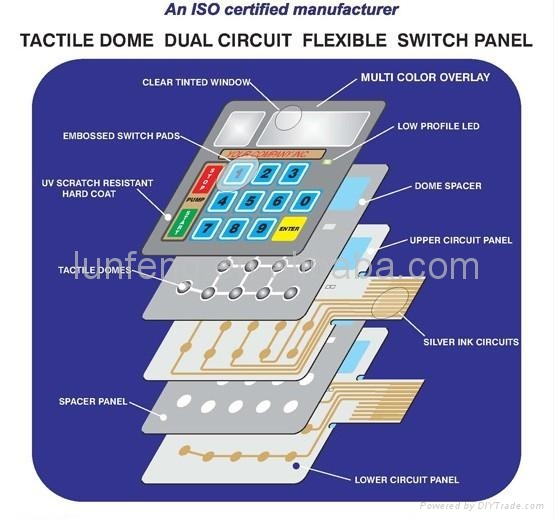Innovative Membrane Switch Solutions for Customized Control Panels
Innovative Membrane Switch Solutions for Customized Control Panels
Blog Article
Recognizing Membrane Switches Over: The Key to Dependable and long lasting Controls

What Are Membrane Layer Switches?
Membrane switches are an innovative option in the realm of individual interface innovation, combining functionality and layout perfectly. These gadgets act as a user interface in between users and electronic systems, incorporating numerous elements right into a portable format. Typically constructed from versatile, thin layers of materials, membrane switches are made to reply to touch, enabling users to communicate with machinery and electronic devices efficiently.
The main aspects of a membrane switch include a printed circuit layer, visuals overlay, and a spacer layer that protects against unplanned activation. The visuals overlay can be tailored to show brand identity or individual choices, improving appearances while making certain use. Membrane layer buttons are generally made use of in different applications, including clinical tools, consumer electronics, and commercial tools, owing to their durability and resistance to ecological aspects such as wetness and dirt.
One of the crucial benefits of membrane layer buttons is their ability to stand up to deterioration, making them perfect for high-traffic atmospheres. In addition, they are lightweight and require very little area, enabling for ingenious designs in item development. Overall, membrane switches represent a reliable and sensible choice for modern digital interfaces, weding innovation with user-centric design concepts.
Exactly How Membrane Layer Changes Job
The procedure of membrane switches over hinges on a basic yet effective device that converts customer input right into electronic signals. When a user presses the switch, the leading layer flaws, enabling a conductive aspect in the circuit layer to make contact with an equivalent conductive pad on the underside of the visuals overlay.
The style of membrane layer switches can differ, however they commonly include domes or tactile aspects to give comments to the individual, boosting the overall experience - membrane switch. The materials utilized in membrane layer switches, such as polyester or polycarbonate, add to their longevity and resistance to ecological elements, including moisture and dirt. The published circuits are normally enveloped, which secures them from wear and tear over time.
Benefits of Membrane Switches

In addition, membrane layer buttons are known for their toughness. Created from durable materials, they are resistant to dirt, wetness, and physical wear, which dramatically prolongs their life-span compared to traditional mechanical switches. This sturdiness makes them particularly ideal for high-traffic settings and applications needing long life.
An additional considerable benefit is the simplicity of cleansing and maintenance. The smooth surface of membrane layer switches over reduces dirt accumulation and is commonly unsusceptible spills, making them suitable for settings that need regular sanitization.
In addition, membrane buttons use a structured account, leading to a thinner style that can be integrated right into various tools without adding mass. This feature not only enhances the visual appeal yet likewise adds to a much more ergonomic item layout.
Applications of Membrane Layer Switches
Functional and straightforward, membrane layer switches find applications across a large range of markets, consisting of clinical tools, customer electronic devices, and industrial tools. In the clinical field, these switches are important to gadgets such as diagnostic devices, person monitoring systems, and mixture pumps, where dependability and ease of cleaning are important. Their capacity to keep and hold up against rough environments functionality makes them optimal for such applications.

In consumer electronics, membrane buttons are utilized in items like microwaves, washing makers, and remotes - membrane switch. more helpful hints Their streamlined style permits instinctive individual interfaces, boosting the total user experience while providing durability and resistance to use and tear
Commercial devices likewise gains from membrane buttons, specifically in control panels for equipment and automation systems. These buttons use security against dirt and wetness, making sure constant performance in difficult environments. Their personalized attributes allow suppliers to customize them to details operational requirements, enhancing performance and functionality.
Choosing the Right Membrane Layer Switch
When picking a membrane button, it is important to think about numerous factors that influence efficiency and viability for certain applications. The key factors to consider consist of environmental problems, responsive feedback, durability, and layout specs.
First, examine the operating setting; switches exposed to moisture, chemicals, or severe temperatures call for particular materials to make sure longevity and functionality. Next, examine the need for responsive responses. Depending on individual communication, some applications may gain from a responsive reaction to verify activation, while others may favor a non-tactile design for visual factors.
Durability is one more crucial variable; membrane buttons need to be made to endure regular use, influences, and abrasion. Make certain the chosen switch can sustain the anticipated lifecycle, especially in high-usage situations.

Verdict
In conclusion, membrane layer changes serve as essential components in the style of sturdy and dependable control systems throughout various sectors. The adaptability of membrane layer changes enables for tailored remedies that satisfy particular functional requirements, enhancing their value in modern technology.
Membrane layer switches webpage represent an important aspect of contemporary user interface design, blending functionality with resilience in numerous applications.Membrane switches are an advanced option in the realm of user interface technology, integrating capability and style flawlessly. Typically created from flexible, thin layers of materials, membrane layer buttons are developed to react to touch, allowing individuals to connect with machinery and investigate this site digital tools effectively.
The style of membrane switches can differ, however they frequently include domes or responsive elements to supply responses to the individual, enhancing the total experience.In conclusion, membrane changes serve as important parts in the layout of sturdy and trustworthy control systems throughout various sectors.
Report this page